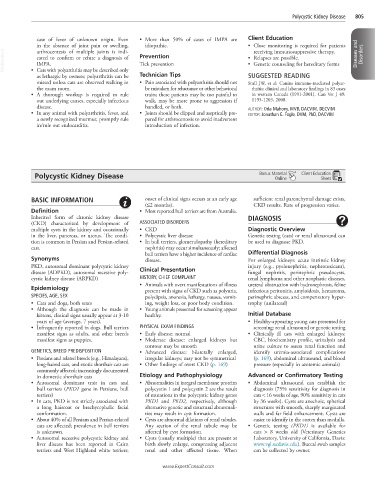Page 1599 - Cote clinical veterinary advisor dogs and cats 4th
P. 1599
Polycystic Kidney Disease 805
case of fever of unknown origin. Even • More than 50% of cases of IMPA are Client Education
in the absence of joint pain or swelling, idiopathic. • Close monitoring is required for patients
VetBooks.ir cated to confirm or refute a diagnosis of Prevention • Relapses are possible. Diseases and Disorders
arthrocentesis of multiple joints is indi-
receiving immunosuppressive therapy.
• Genetic counseling for hereditary forms
Tick prevention
IMPA.
• Cats with polyarthritis may be described only
as lethargic by owners; polyarthritis can be Technician Tips SUGGESTED READING
missed unless cats are observed walking in • Pain associated with polyarthritis should not Stull JW, et al: Canine immune-mediated polyar-
the exam room. be mistaken for reluctance or other behavioral thritis: clinical and laboratory findings in 83 cases
• A thorough workup is required to rule traits; these patients may be too painful to in western Canada (1991-2001). Can Vet J 49:
out underlying causes, especially infectious walk, may be more prone to aggression if 1195-1203, 2008.
disease. handled, or both. AUTHOR: Orla Mahony, MVB, DACVIM, DECVIM
• In any animal with polyarthritis, fever, and • Joints should be clipped and aseptically pre- EDITOR: Jonathan E. Fogle, DVM, PhD, DACVIM
a newly recognized murmur, promptly rule pared for arthrocentesis to avoid inadvertent
in/rule out endocarditis. introduction of infection.
Polycystic Kidney Disease Bonus Material Client Education
Online
Sheet
BASIC INFORMATION onset of clinical signs occurs at an early age sufficient renal parenchymal damage exists,
(≤2 months). CKD results. Rate of progression varies.
Definition • Most reported bull terriers are from Australia.
Inherited form of chronic kidney disease DIAGNOSIS
(CKD) characterized by development of ASSOCIATED DISORDERS
multiple cysts in the kidney and occasionally • CKD Diagnostic Overview
in the liver, pancreas, or uterus. The condi- • Polycystic liver disease Genetic testing (cats) or renal ultrasound can
tion is common in Persian and Persian-related • In bull terriers, glomerulopathy (hereditary be used to diagnose PKD.
cats. nephritis) may occur simultaneously; affected
bull terriers have a higher incidence of cardiac Differential Diagnosis
Synonyms disease. For enlarged kidneys: acute intrinsic kidney
PKD, autosomal dominant polycystic kidney Clinical Presentation injury (e.g., pyelonephritis, nephrotoxicant),
disease (ADPKD), autosomal recessive poly- fungal nephritis, perinephric pseudocysts,
cystic kidney disease (ARPKD) HISTORY, CHIEF COMPLAINT renal lymphoma and other neoplastic diseases,
• Animals with overt manifestations of illness ureteral obstruction with hydronephrosis, feline
Epidemiology present with signs of CKD such as polyuria, infectious peritonitis, amyloidosis, hematoma,
SPECIES, AGE, SEX polydipsia, anorexia, lethargy, nausea, vomit- perinephric abscess, and compensatory hyper-
• Cats and dogs, both sexes ing, weight loss, or poor body condition. trophy (unilateral)
• Although the diagnosis can be made in • Young animals presented for screening appear
kittens, clinical signs usually appear at 3-10 healthy. Initial Database
years of age (average, 7 years). • Healthy-appearing young cats presented for
• Infrequently reported in dogs. Bull terriers PHYSICAL EXAM FINDINGS screening: renal ultrasound or genetic testing
manifest signs as adults, and other breeds • Early disease: normal • Clinically ill cats with enlarged kidneys:
manifest signs as puppies. • Moderate disease: enlarged kidneys but CBC, biochemistry profile, urinalysis and
contour may be smooth urine culture to assess renal function and
GENETICS, BREED PREDISPOSITION • Advanced disease: bilaterally enlarged, identify uremia-associated complications
• Persians and related breeds (e.g., Himalayans), irregular kidneys; may not be symmetrical (p. 169), abdominal ultrasound, and blood
long-haired cats, and exotic shorthair cats are • Other findings of overt CKD (p. 169) pressure (especially in azotemic animals)
commonly affected; increasingly documented
in domestic shorthair cats Etiology and Pathophysiology Advanced or Confirmatory Testing
• Autosomal dominant trait in cats and • Abnormalities in integral membrane proteins • Abdominal ultrasound can establish the
bull terriers (PKD1 gene in Persians, bull polycystin 1 and polycystin 2 are the result diagnosis (75% sensitivity for diagnosis in
terriers) of mutations in the polycystic kidney genes cats < 16 weeks of age, 90% sensitivity in cats
• In cats, PKD is not strictly associated with PKD1 and PKD2, respectively, although by 36 weeks). Cysts are anechoic, spherical
a long haircoat or brachycephalic facial alternative genetic and structural abnormali- structures with smooth, sharply marginated
conformation. ties may result in cyst formation. walls and far field enhancement. Cysts are
• About 40% of all Persians and Persian-related • Cysts are abnormal dilations of renal tubules. easier to identify in the cortex than medulla.
cats are affected; prevalence in bull terriers Any section of the renal tubule may be • Genetic testing (PKD1) is available for
is unknown. affected by cyst formation. cats > 8 weeks old (Veterinary Genetics
• Autosomal recessive polycystic kidney and • Cysts (usually multiple) that are present at Laboratory, University of California, Davis:
liver disease has been reported in Cairn birth slowly enlarge, compressing adjacent www.vgl.ucdavis.edu). Buccal swab samples
terriers and West Highland white terriers; renal and other affected tissue. When can be collected by owner.
www.ExpertConsult.com

